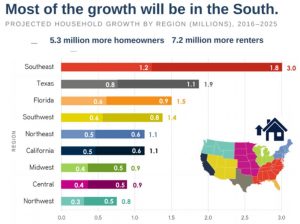In our November 25th, 2019 article, The Power Of The Buy & Hold Model, we outlined 5 strong benefits of owning rental homes for the long term. But what kind of homes should you target? Where should they be? How do you identify and ultimately acquire properties that will help you build wealth over the long term?
There are 3 components to focus on. You win in rental property investing when you win on the market, the team and the deal.
The Team
In our previous articles, ‘It’s Not the X’s and the O’s It’s the Jane’s and the Joe’s” and “A Deeper Dive On Evaluating Potential Real Estate Partners & Teammates (And Yourself)” we established the importance of having the right people on your team helping with the aspects of real estate investing that you don’t manage yourself. To summarize: “Superior team members have a tendency to adjust to their situation and still find a way to get positive results and overcome a flawed plan. The converse is not true, if you have a superior plan and an inferior team that cannot execute you will not succeed in the long run”.
The focus of this article will be on how to identify markets and deals.
The Geographic Market
You may often read or hear about a “HOT” geography for real estate. Initially this buzz may draw your attention to that particular market and get you excited about investing in it. But, should you invest in a “HOT” real estate geography? The first thing that needs to be established is, what exactly does “HOT” mean? Does “HOT” mean there are a lot of transactions happening in the market? Does it mean it’s trendy and people are emotionally attracted to the area for some reason? Does it mean prices are rising rapidly? Does it mean that homes are only on the market a few days before selling? Does it mean there is a lot of new building occurring? “HOT” could be used to describe all of these circumstances, but they have very different ramifications on investors.
Pay More Attention To A Geographic Market’s Fundamentals
Basing real estate investing decisions on terms like “HOT” or any other broad adjective is not advised. There are several key demographic, economic and mathematical variables that will truly help determine which cities to invest in and it is not rocket science.
Population Growth & Job Growth
The most fundamental economic driver of any asset or commodity is supply and demand. You want to invest in cities where there is current and projected high demand for rental homes and this ties back to demographics. The number one variable to look at is population growth. How fast has a cities’ population grown in recent years and more importantly what are the population projections for that city. It’s very simple, the more people there are the more housing (both owner occupied and rental) that will be needed. As an owner of the supply, strong demand is your friend.
Another key variable to look at is job growth. What is happening to the companies in the city you are evaluating. Are they expanding? Is work getting outsourced to other geographies? Is the city attracting more companies? It is important that as your selected city grows in population there are enough well paying jobs for its residents. As a rental home owner you need a steady supply of people who can afford your rent.
Household Formation
Another important metric that dictates housing demand is household formation. The most common driver of household formation is when young adults move out of the family home and get started on their own. The chart below, courtesy of John Burns consulting, shows that between 2016 and 2025, there are expected to be 12.5 million new households formed. Note that almost 60% of new households are expected to be renter households and that the Southeast is, by far, the region with the highest amount of expected household formation.

Taxes and Insurance
As a rental property owner, there are monthly costs that are necessary and unavoidable. Two such costs are taxes and insurance. Taxes and insurance costs vary widely by state and are a key factor on how your investment performs. Omaha, Nebraska has some very favorable demographic, job and population trends. But, the state of Nebraska has high costs for both taxes and insurance which significantly reduces cash flow and makes the market generally unattractive for those that want to take advantage of the 5 powerful benefits of investing in rental homes. Long term acquire and hold investors should choose a market that skews lower on at least one of these unavoidable costs and ideally both of them.
Affordability
Assuming you are investing for cash flow, you must select a market that is “affordable”. While there is certainly a segment of the investor population that likes to invest in high priced areas and play the appreciation game, having a cash flowing (tax sheltered cash flow at that) property is less speculative. Furthermore it is easier to scale and scale quicker in affordable geographies as an individual housing unit won’t require as much capital compared to a high priced, non-affordable market. Most major cities on the coasts, like NY, San Francisco, Los Angeles, Miami, Seattle, Boston, etc… fall into the non affordable bucket. As housing price growth has continued to outpace rent growth (which has also been very healthy) even some inland “secondary” markets, such as Denver, Austin and Nashville have become unaffordable for the cash flow seeking investor.
The Market – Summary
The Southeastern part of the United States is currently a very attractive place to seek out investment homes for the acquire and hold model. The region in general is experiencing both job and population growth. Household formation metrics are very favorable. There are several states in the region that fare well on the tax and insurance cost spectrum. Compared to most primary and secondary markets west of the Mississippi River and along the East Coast, in general, properties in Southeast are relatively affordable.
The Deal
So you have identified a market that you like and fits your investment objectives. You know how to identify team members that can help execute your investment strategy. But how do you know if a particular house at 123 Main St in Anytown USA will help you build wealth? How do you know if it’s a good deal? Similar to markets, there are some basic fundamentals to evaluate when selecting a particular home.
Rent To Price Ratio
A very quick way to determine if a home would be a good rental is to see how closely it complies with “the 1% rule”. To evaluate this rule, determine what the property will rent for and divide it by the cost of the property. The higher the rent, relative to the cost, the better. Close to 1% or higher is a property worth investigating further. For example if a home costs $150K and it can be rented for $1,395, the monthly rent to price ratio is .93% (fairly close to 1% and worth additional evaluation) If a home rents for $1,895 and the cost is $275K your ratio would be .67% which for the cash flow seeking investor is too far away from the 1% rule.
Neighborhood Type & Rental Amount
The 1% rule can’t be your only tool to evaluate a property. A home that costs $70K may be able to be rented for $800 (Rent to Price = 1.1%) But a $70,000 home may not be in the best neighborhood. It may attract the type of tenant that is more transient and less likely to stay for a long period of time. There are costs incurred that are not insignificant every time a tenant moves out of one of your properties. Be careful to not fall in too much love with the numbers on a spreadsheet. The risks to the model are vacancy and maintenance and these have a tendency to be higher in neighborhoods where property values are lower. A good rule of thumb in addition to the 1% rule is to target monthly rents of $1,000 or higher.
Motivation Of Seller
It is always helpful, if possible, to understand the motivations of the seller who is offering the property. Why are they selling, how quickly do they want to sell, is the seller another investor and is the seller willing to negotiate are all great things to uncover when evaluating a real estate investment opportunity. The greater the motivation of the seller to move on from the property, the more likely you are to get a good deal.
Costs Assessment
It is very important to make sure you account for all of the recurring costs and potential periodic costs you will incur as a rental property owner. Assuming you use smart debt you will have the following monthly recurring costs:
- Principal & Interest (you should shop for the best loan terms)
- Property Taxes
- Homeowners Insurance
- Homeowners Association Dues (potentially)
- Property Management Fees (assuming you don’t self manage)
- Utilities/Landscaping Maintenance (potentially- more likely in a multi unit property)
- Umbrella Insurance Policy (potentially if desired)
Make sure to appropriately account for general vacancy & maintenance, the two biggest risks to the acquire and hold model. Pay especially close attention to the Big 4 potential maintenance items:
- Roof
- HVAC
- Plumbing
- Electrical
You will want to understand the usable life left for all of them. A roof that needs to be replaced within a few years after purchase or an HVAC system that is already 20 years old can significantly blemish your returns in the short term.
Basic Cash On Cash Return
A great tool used to compare various properties you are analyzing is cash on cash return. After subtracting all of your monthly recurring costs from your income (rent) you will have your monthly cash flow. If you then multiply this number by 12, you will get your yearly cash flow. Take your yearly cash flow and divide it by the amount of your down payment (amount invested in the deal) and you will get your basic cash on cash return.
Potential Appreciation
Remember, your cash flow is just one of the benefits. That cash flow will be tax sheltered due to your ability to depreciate the property over a 27.5 year period. Another strong benefit of the buy and hold model is appreciation. Appreciation is not guaranteed, but if you choose the right deal in the right market and neighborhood you should experience the benefits of appreciation. Appreciation helps build equity and equity can be very powerful.
Summary
Knowing how to select the right geographic market, team and individual deal are keys to building wealth through rental property investing. Within each of these 3 components are fundamental concepts and metrics to focus on which will help you to efficiently decide what opportunities will be best for you to pursue.












